Introduction: The Pourbus Artistic Legacy
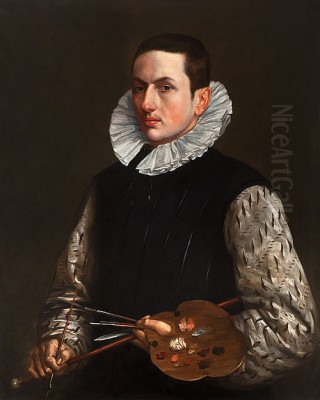
The second half of the sixteenth century witnessed a flourishing of artistic activity in the Southern Netherlands, particularly in the vibrant cities of Bruges and Antwerp. Amidst this creative ferment, the Pourbus family established itself as a significant artistic dynasty. Frans Pourbus the Elder (c. 1545–1581) stands as a key figure within this lineage, bridging the gap between the established traditions of his father and the international renown achieved by his son. Active during a period of transition in Flemish art, Frans the Elder carved out a distinct identity, primarily excelling in portraiture and religious compositions that reflected both local traditions and the burgeoning influence of the Italian Renaissance.
Born into an artistic household, Frans Pourbus the Elder inherited a rich legacy. His father, Pieter Pourbus (c. 1523–1584), was a leading master in Bruges, known for his meticulously detailed portraits, religious scenes, and even cartography. This environment undoubtedly shaped Frans's early development, providing him with foundational skills and an understanding of the art market. However, Frans the Elder was not merely an imitator; he developed his own refined style, contributing significantly to the artistic landscape of his time before his tragically early death.
Early Life and Artistic Formation
Frans Pourbus was born in Bruges around 1545. His initial artistic education naturally took place under the guidance of his father, Pieter Pourbus. In Pieter's workshop, Frans would have learned the fundamentals of drawing, composition, and oil painting techniques, likely assisting his father on various commissions. The elder Pourbus's style, characterized by sharp observation, clear linearity, and a somewhat reserved depiction of sitters, provided a solid grounding in the Netherlandish tradition.
Seeking broader horizons and exposure to more contemporary trends, Frans the Elder moved to Antwerp, the bustling economic and artistic hub of the Low Countries. There, he entered the prestigious workshop of Frans Floris (c. 1519–1570). Floris was a central figure in introducing and popularizing the Italian High Renaissance style – often termed Romanism – in the North. Having studied in Italy himself, Floris ran a large, highly organized workshop, attracting numerous talented pupils who disseminated his Italianate manner across Northern Europe.
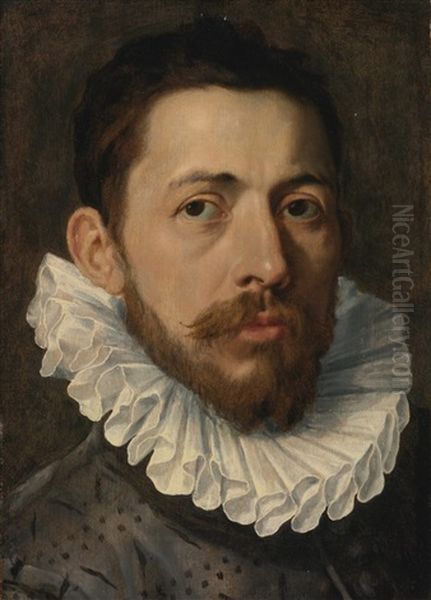
Studying with Floris was a transformative experience for Pourbus. He absorbed the principles of idealized human form, dynamic composition, and a richer, more painterly technique than typically practiced in Bruges. This exposure to Italianism, filtered through Floris's interpretation, added a layer of sophistication and monumentality to the precise observational skills Pourbus had learned from his father. In 1569, Frans Pourbus the Elder was officially registered as a master in the Guild of Saint Luke in Antwerp, marking his independence as a professional artist. He also became a member of the Bruges Guild, maintaining ties with his city of origin.
The Antwerp Milieu: Floris's Workshop and Contemporaries
The workshop of Frans Floris was a crucible of artistic talent in mid-16th century Antwerp. Pourbus trained alongside other notable artists who would go on to have significant careers, including Crispijn van den Broeck (c. 1523–c. 1591), Marten de Vos (1532–1603), Ambrosius Francken the Elder (1544–1618), and Hieronymus Francken the Elder (c. 1540–1610). This environment fostered both collaboration and competition, pushing young artists to refine their skills and absorb the master's influential style.
Frans Floris's impact cannot be overstated. He introduced Antwerp artists to the anatomical understanding, heroic figures, and complex allegorical themes prevalent in Italian art, particularly the works of Michelangelo and Raphael. His workshop operated almost like an academy, producing a large volume of work, often with significant contributions from his pupils. This collaborative aspect was crucial for the training and development of artists like Pourbus.
Following Frans Floris's death in 1570, his pupils were sometimes tasked with completing unfinished works. Historical records suggest that Frans Pourbus the Elder, likely alongside his fellow pupil Crispijn van den Broeck, collaborated on finishing some of Floris's commissions. This demonstrates Pourbus's recognized skill and his close connection to the master's legacy even after establishing his independent career. Working alongside artists like Van den Broeck further cemented his position within the Antwerp artistic community.
Artistic Style: Precision and Elegance
Frans Pourbus the Elder developed a distinctive style that skillfully synthesized the Netherlandish tradition of meticulous realism with the elegance and idealized forms of Italianism learned under Floris. His works are characterized by careful attention to detail, particularly in the rendering of fabrics, jewelry, and textures, a trait likely inherited from his father, Pieter Pourbus. Lace collars, velvet doublets, intricate embroidery, and gleaming pearls are depicted with remarkable precision, providing valuable insights into the fashions of the era.
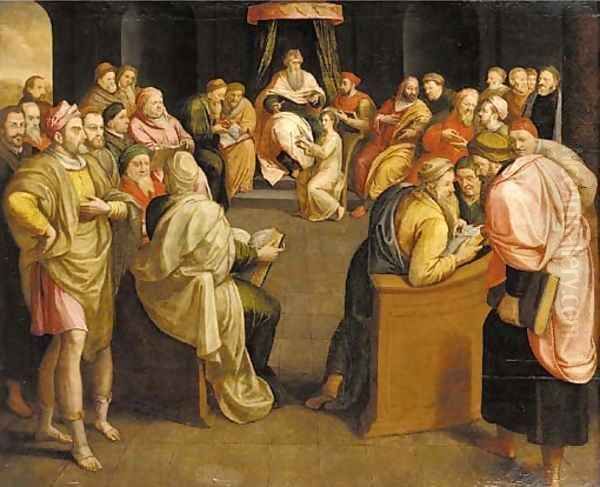
However, Pourbus went beyond mere surface description. Influenced by Floris, his figures often possess a greater sense of volume and physical presence than those of earlier Netherlandish masters. While not adopting the full dynamism of the High Renaissance, his compositions are well-balanced, and his figures are posed with a certain grace and composure. He demonstrated a keen understanding of light and shadow, using subtle modeling to define form and create a sense of three-dimensionality.
His color palette is generally rich and harmonious, often employing deep reds, blacks, and golds, contrasted with the pale complexions of his sitters. In his portraits, Pourbus excelled at capturing a convincing likeness while also conveying the sitter's social status and a sense of reserved dignity. While perhaps not as psychologically penetrating as the later portraits by Rembrandt or even his own son, Frans the Younger, his works possess a quiet intensity and refined objectivity that was highly valued by his patrons.
Focus on Portraiture
Portraiture formed the core of Frans Pourbus the Elder's oeuvre. He catered primarily to the affluent bourgeoisie and nobility of Flanders. His ability to render likenesses accurately while simultaneously conveying an air of sophistication and status made him a sought-after portraitist in both Bruges and Antwerp. His sitters are typically presented against neutral, dark backgrounds, focusing attention entirely on the individual.
His portraits often follow established conventions, such as the three-quarter view, but Pourbus imbued them with a lifelike quality through his meticulous technique and subtle handling of expression. He paid extraordinary attention to the details of costume and accessories, which served not only as indicators of wealth and fashion but also allowed him to showcase his technical virtuosity. The rendering of different materials – the sheen of silk, the texture of fur, the hardness of jewels – is consistently impressive.
While many of his sitters remain unidentified, works like the Portrait of a Man (often dated around the 1570s) exemplify his approach. The subject is presented with sober dignity, his gaze direct yet reserved. The detailed rendering of his dark attire and white ruff contrasts effectively with the smoothly modeled face. Pourbus captures individuality without sacrificing the formal decorum expected in portraits of this period. His work in this genre provided a strong foundation for his son, Frans Pourbus the Younger, who would later become an internationally renowned court portraitist.
Religious and Historical Paintings
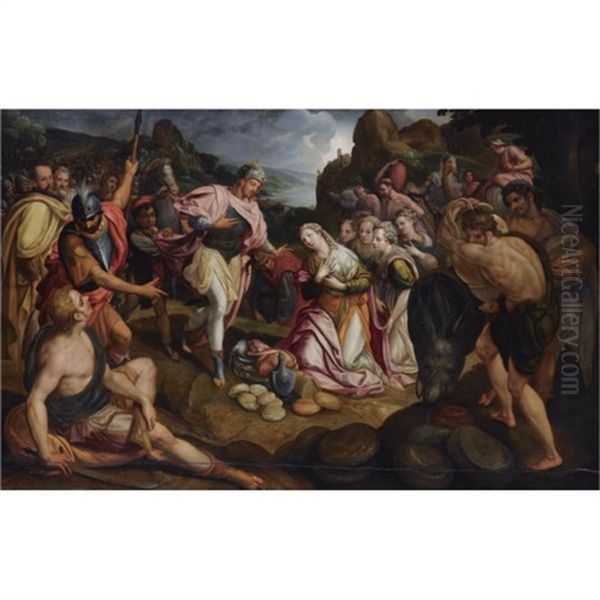
Besides portraiture, Frans Pourbus the Elder also produced religious and, to a lesser extent, historical or allegorical works. These paintings often show a more pronounced influence from Frans Floris and the Italianate style, featuring more complex compositions and a greater number of figures than his portraits. His religious scenes blend narrative clarity with the detailed realism characteristic of Flemish art.
A significant example is the Viglius Aytta Triptych, also known as Christ Among the Doctors, painted around 1571 for Viglius van Aytta, a prominent statesman, for his funerary chapel in St. Bavo's Cathedral, Ghent. The central panel depicts the young Jesus debating with the learned men in the temple. Pourbus handles the multi-figure composition skillfully, arranging the figures in a dynamic yet ordered manner. The expressions and gestures convey the narrative effectively, while the architectural setting adds depth. The side panels feature portraits of Viglius Aytta himself, presented by his patron saint, demonstrating Pourbus's ability to integrate portraiture within a larger religious context.
Another notable work mentioned in historical sources is David and Abigail. While the specific painting's current location or definitive attribution might be debated by scholars, the theme itself – a popular Old Testament subject involving diplomacy and humility preventing conflict – allowed for rich costumes, expressive figures, and a landscape or architectural background, playing to Pourbus's strengths. These religious works demonstrate his versatility and his engagement with the dominant artistic trends of his time, combining narrative demands with his characteristic attention to detail.
The Hoefnagel Family Portrait
Among his most celebrated group portraits is the Portrait of the Hoefnagel Family, painted around 1580-1581. This work depicts the family of the wealthy Antwerp merchant, Jan van Hoefnagel. Group portraiture presented unique challenges in composition and capturing individual likenesses while maintaining a cohesive whole. Pourbus masterfully arranges the family members, creating a sense of familial connection and individual presence.
The painting is a testament to the prosperity and status of the Hoefnagel family, showcased through their rich attire and confident demeanors. Pourbus's meticulous rendering of fabrics, lace, and jewelry is particularly evident here. The composition balances formality with a degree of intimacy, suggesting the family's unity and social standing. This work stands as a prime example of Flemish Renaissance portraiture, documenting not only the appearance of the sitters but also the social values and material culture of the time. It highlights Pourbus's skill in managing complex compositions involving multiple figures, a skill likely honed during his time in Floris's busy workshop.
Context within the Flemish Art Scene
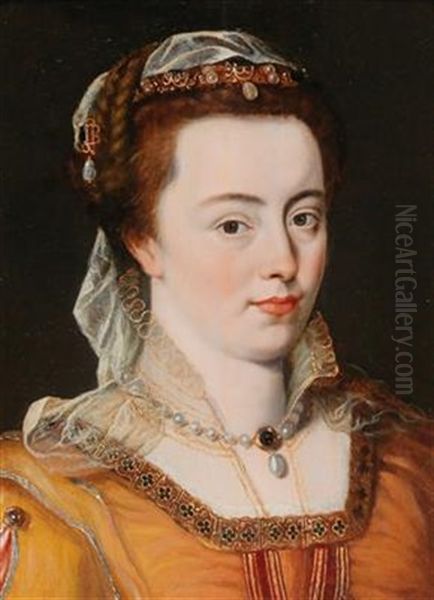
Frans Pourbus the Elder worked during a dynamic period in Flemish art history. Antwerp, where he spent a significant part of his career, was a major center for artistic innovation and production. He was a contemporary of giants like Pieter Bruegel the Elder (c. 1525–1569), although their styles and primary subjects differed significantly. While Bruegel focused on peasant life, landscapes, and satirical or allegorical themes, Pourbus concentrated on more traditional genres like portraiture and religious history painting, catering to a different clientele.
His training under Floris placed him firmly within the Romanist camp, artists who looked to Italy for inspiration. This contrasted with artists who remained more rooted in the purely local Netherlandish traditions. Pourbus's style represents a successful mediation between these trends. He adopted Italianate elements like idealized forms and balanced compositions but retained the Northern European emphasis on detailed realism and texture.
Other important contemporaries in Antwerp included portraitists like Adriaen Thomasz Key (c. 1544–after 1589), who also produced sober and realistic portraits of the bourgeoisie, and the prolific Marten de Vos, Pourbus's fellow pupil under Floris, who excelled in large-scale religious and allegorical works. The artistic environment was rich and competitive, demanding high levels of technical skill and adaptability. Pourbus carved out his niche through the refinement and elegance of his portraiture and the clarity of his religious narratives. His work can be seen as representative of the mainstream, high-quality production favored by the established elite of Flanders.
The Pourbus Dynasty: Father and Son
Understanding Frans Pourbus the Elder requires acknowledging his place within the Pourbus artistic dynasty. His father, Pieter Pourbus, established the family's reputation in Bruges. Pieter was a versatile artist, also active as a surveyor and cartographer, embodying the multi-talented Renaissance man. His style was precise, linear, and somewhat conservative, deeply rooted in the Bruges tradition tracing back to Jan van Eyck and Hans Memling. Frans the Elder learned these fundamentals but modernized his approach through his Antwerp training.
Frans the Elder's own son, Frans Pourbus the Younger (1569–1622), would achieve even greater fame. Born shortly before his grandfather Floris's death, Frans the Younger likely received his initial training from his father, Frans the Elder, and possibly his grandfather Pieter Pourbus after his father's early death. Frans the Younger built upon the family's reputation for portraiture, developing a highly polished, internationally sought-after style. He became a court painter, working for the Gonzaga Dukes in Mantua (where he interacted with Peter Paul Rubens), and later for the French royal court under Marie de' Medici and Louis XIII.
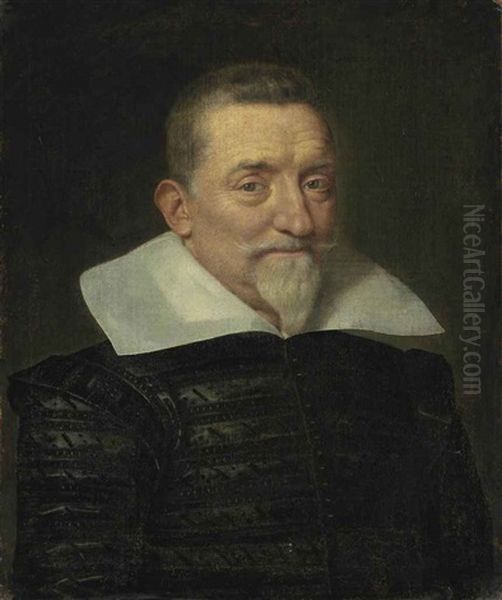
The shared name across three generations (Pieter, Frans the Elder, Frans the Younger) has sometimes led to confusion in attributions. However, each artist has a distinct style. Frans the Elder acts as a crucial link: he absorbed the Bruges tradition from Pieter, embraced the Antwerp Italianism of Floris, and passed on a refined portraiture practice that his son, Frans the Younger, developed into an international court style. The Elder's relatively short career makes his contribution perhaps less voluminous than his father's or son's, but no less significant in the evolution of Flemish painting.
Untimely Death and Legacy
Frans Pourbus the Elder died in Antwerp in 1581, likely during a typhoid epidemic that swept through the city. He was only in his mid-thirties. His premature death cut short a promising career. Had he lived longer, his oeuvre would undoubtedly have been larger, and his influence potentially even greater. His passing occurred just three years before his father, Pieter Pourbus, died in Bruges.
Despite his relatively brief working life, Frans Pourbus the Elder left a tangible legacy. His paintings, particularly his portraits and key religious works like the Viglius Aytta Triptych, are held in major museums and collections across Europe, including the Groeningemuseum in Bruges, the Royal Museums of Fine Arts of Belgium in Brussels, and St. Bavo's Cathedral in Ghent.
His primary legacy lies in his contribution to Flemish portraiture. He refined the genre, blending meticulous Netherlandish detail with a newfound elegance and psychological presence influenced by Italian art via Floris. He set a high standard for technical execution and sophisticated representation that influenced subsequent portrait painters in the region. Furthermore, he played a vital role in the Pourbus family's artistic continuity, transmitting skills and reputation to his son, Frans the Younger, who would carry the family name onto the grand stages of European courts.
Art Historical Significance and Evaluation
In the grand narrative of art history, Frans Pourbus the Elder occupies a specific but important place. He represents the generation of Flemish artists who navigated the complex interplay between native traditions and the powerful influence of the Italian Renaissance. Working between the era of Pieter Bruegel the Elder and the rise of the Baroque masters like Peter Paul Rubens (1577–1640) and Anthony van Dyck (1599–1641), Pourbus exemplifies the high level of craftsmanship and evolving aesthetic sensibilities of the late 16th century in Flanders.
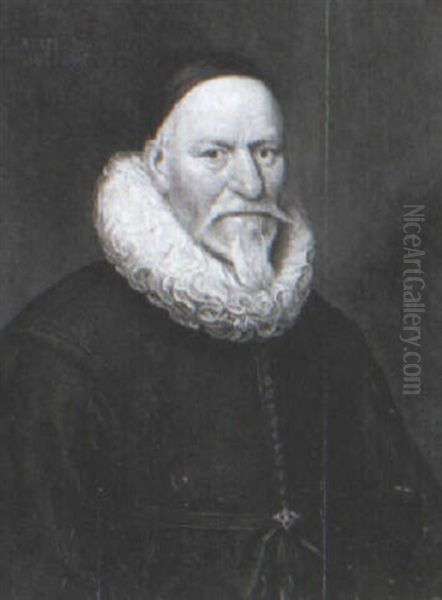
While perhaps overshadowed in popular recognition by his father's foundational work in Bruges and his son's international court career, art historians recognize Frans the Elder's distinct contribution. His training under both Pieter Pourbus and Frans Floris uniquely positioned him to synthesize different artistic currents. His portraits are valuable not only as works of art but also as historical documents, capturing the likenesses and social aspirations of the Flemish elite during a period of significant political and religious change.
His influence can be seen in the development of portraiture in Antwerp and beyond. While Antonis Mor (c. 1517–1577) had earlier established a model for courtly portraiture with Spanish influences, Pourbus offered a slightly different sensibility, perhaps more aligned with the tastes of the local merchant class and nobility. His work demonstrates the vitality of painting in Antwerp even before the arrival of Rubens, showcasing a commitment to realism combined with compositional harmony and refined execution. He remains a testament to the depth of talent within the Flemish school during the later Renaissance.
Conclusion: A Master of Refined Realism
Frans Pourbus the Elder stands as a significant master of the Flemish Renaissance, a crucial link in an important artistic dynasty. His career, though tragically shortened, was marked by the successful fusion of the meticulous realism inherited from his father, Pieter Pourbus, and the Italianate elegance absorbed from his teacher, Frans Floris. Primarily celebrated for his portraits, he captured the likenesses of the Flemish elite with remarkable precision, paying close attention to the textures of fabrics and the details of adornment, while imbuing his sitters with a sense of dignified presence.
His religious works, such as the Viglius Aytta Triptych, demonstrate his ability to handle complex narrative compositions with clarity and skill. Active in the vibrant artistic centers of Bruges and Antwerp, he contributed to the rich tapestry of late 16th-century Netherlandish art, working alongside notable contemporaries and helping to shape the artistic landscape. Though sometimes confused with his father or his more famous son, Frans Pourbus the Elder possesses a distinct artistic identity characterized by technical brilliance and refined sensibility. His work continues to be appreciated for its artistry and as a valuable window onto the society and culture of his time.